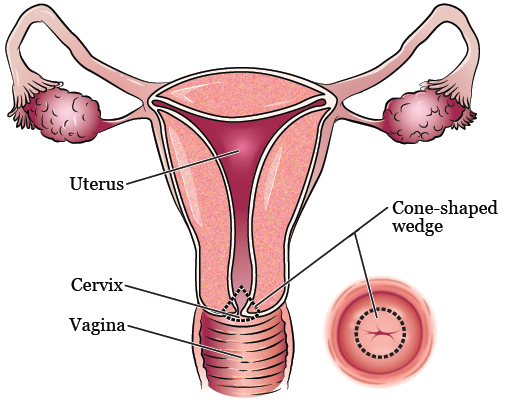This information explains how to care for yourself after a cone biopsy of your cervix.
About Your Cone Biopsy of the Cervix
Your cervix is the bottom part of your uterus. It connects your uterus to your vagina (see Figure 1). It’s the part of your uterus that dilates (opens) during childbirth. When you have your period, menstrual blood flows through your cervix to your vagina and out of your body.

Figure 1. Uterus, cervix, and vagina
During a cone biopsy, your healthcare provider will remove a small, cone-shaped part of your cervix. They will study it under a microscope to look for abnormal cells.
It usually takes about 4 to 6 weeks for your cervix to heal after this procedure.
Caring for Yourself at Home
In the first 24 hours after your procedure:
- Drink 8 to 12 (8-ounce) glasses of liquids.
- Eat well-balanced, healthy meals.
The first 4 days after your procedure, you may have vaginal discharge that looks like menstrual bleeding. The amount varies for everyone.
- Use sanitary pads for vaginal discharge.
- Over the next 2 to 3 weeks after your procedure, your vaginal discharge will become clear and watery and then will stop.
For 4 to 6 weeks after your procedure or until your healthcare provider tells you your cervix is healed:
- Don’t put anything inside your vagina (such as tampons and douches) or have vaginal intercourse.
- Take showers instead of baths. Don’t soak in water (such as swimming pools, hot tubs, or baths).
- Don’t do any heavy housework (such as vacuuming, yard work, or carrying groceries or laundry).
- Don’t lift objects over 10 pounds (4.5 kilograms).
- Don’t do any strenuous exercise (such as running and aerobics).
Your next period may be late, or you may have a heavier blood flow than usual.
Call your healthcare provider’s office to schedule a follow-up visit. This should be about 4 weeks after your procedure.
Call Your Healthcare Provider if You Have:
- A fever of 101° F (38.3° C) or higher
- Chills
- Large blood clots or heavy bleeding that fills a sanitary pad every 1 to 2 hours
- Vaginal discharge that smells bad or has a very strong smell
- Pain that isn’t helped by pain medications
- Any other questions or concerns